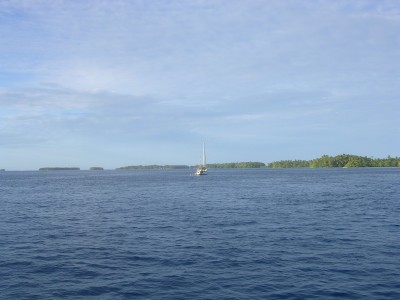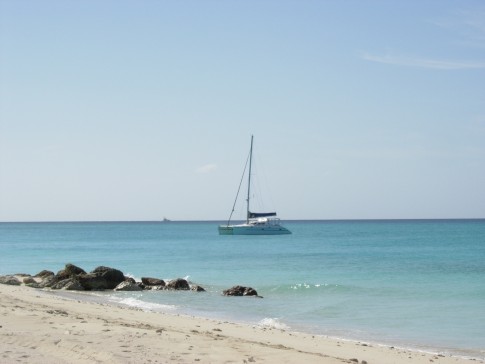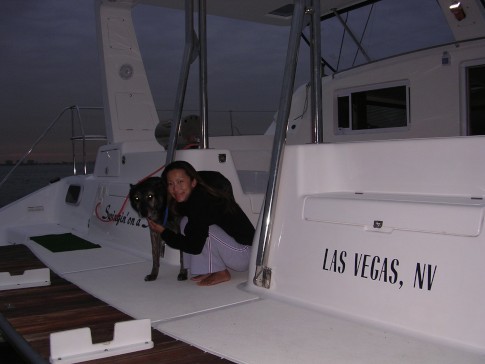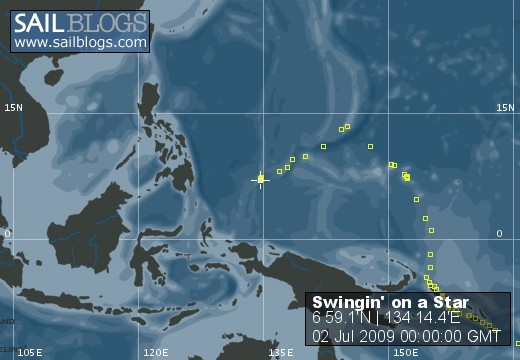
Swingin' on a Star
Ship's log for the circumnavigating Saint Francis 50 catamaran, "Swingin on a Star".
01 April 2010 | Palau
13 July 2009 | Palau
05 July 2009 | Yacht Harbor
03 July 2009 | Peleliu
02 July 2009 | Palau
01 July 2009 | Two Dog Beach
30 June 2009 | Mecharchar
29 June 2009 | Mecharchar
28 June 2009 | Ulong
27 June 2009 | Ngeruktabel
17 June 2009 | Ngeruktabel
16 June 2009 | Ngeruktabel
15 June 2009 | Ngeruktabel
14 June 2009 | Ngeruktabel
13 June 2009 | Ngerutable
25 May 2009 | Yacht Harbor
30 April 2009 | Malakal
29 April 2009 | Koror
28 April 2009 | Malakal
27 April 2009 | Malakal
Ship Rescue
24 January 2009 | South Pacific
Randy

It was after six PM on Friday night when Eric and I made our way to Angelique as she sat stranded on the reef in a falling tide. It was so dark that we had to be very careful not to run aground. There were no stars, no moon and no other outside lights. It was completely disorienting. The islands of Kapingamarangi were sometimes visible, and this occasional shadow was hardly enough to give you an idea of where the snaky reef was.
At asked us to find deep water for him. This was not so easy given the conditions but we used the flood light we had brought to find water at least deep enough to float in. At worked Angleique's engine hard to back her out but the swell (which fortunately was wrapping around from the northeast and not striking her directly) kept her pinned down.
Over the next hour we lost more and more water as we tried every thing we could think of to move Angelique out into deeper water. We tried to tow a line from the bow with the dinghy. We tried pushing with the dinghy. We tried to take a halyard and heel her with the dinghy. All the time At was working Angelique's overheating engine. It was no use. She was fast aground, grinding her keel, and possibly rudder, on the hard coral below.
At this point we decided to run out a kedge and to try and winch her off with the windlass. In retrospect this should have been our first tactic. We knew the tide was falling though and had hoped for a quick fix while the water was near the level she had come on with.
Our dinghy was not the greatest tool in all of this. The control line for the shifter is not setup right and the engine is half in forward when the shifter is set to neutral (the only place it will start) and the reverse wont engage at all. I tried to fix this while we were underway but the cable is not long enough. Running around the choppy water with the rocking Angelique looming overhead with only forward and a slow forward neutral, that generally causes the engine to stall after a minute, was not optimal.
Eric grabbed the heavy dreadnaught anchor that At lowered down to us and we went out in search of the nearest deep water. Angelique was facing West, beam onto the reef and seas, at this point and due to a bulge in the reef here, more west would be worse. East was not good and North was the breakers. So we set the kedge anchor out to the south. We sounded out the area with a lead line and it was deep enough to float Angelique's 2.3 meter draft. Eric jumped onboard Angelique to work the engine while At and Dia operated the winch. The winch up button had failed, of course, and so now Dia was having to short out the solenoid to run the winch while At tailed the rode coming up.
The kedge held and we managed to get Angelique pointing out to deep water. The tide kept falling though. As the scope went vertical on the anchor, Eric jumped back into the dinghy and we went out to pull up the anchor and reset it farther out. The anchor was attached to the bottom. No force we could apply from our battered dink could budge it. We told At he would have to bring it up with the winch.
At this point the massive amounts of power the windlass was drawing was tripping the breaker in seconds. Eric reset the breaker as At hauled up inches at a time. Finally, ping! The anchor came free. We wanted to reset it immediately before we lost any headway we had gained. The swell continued to batter Angelique and rock her from side to side on the reef.
When the anchor finally cleared the water it was a bent mess. After some discussion we decided to use it again anyway. We are anchoring on reef and if it bites it will hold. If it holds it will not let go without fairly serious trauma. Better not to wreck two anchors while this one could still work, it was starting to look like a reef claw anyway.
We took the kedge anchor back out off of the bow again and this time dropped it in fairly deep water a little off the port bow. Even with the tide dropping, if she could make it to here she would be free. It was not to be though. We all worked to move Angelique forward but the swell had calmed and the water had dropped. The lack of swell was nice in that the boat no longer slammed up and down and across the rock, but neither did we have the liberating lift from the waves. The windlass couldn't take much more and everyone was exhausted. Low tide was at 10PM, almost two hours away, but we decided to wait.
I had let Hideko know the situation over the VHF, she was mortified but helpless to do anything but provide moral support from the quiet anchorage. We all climbed aboard the rocking Angelique to wait. Dia made us some hot noodles and we talked and planned as we watched the clock.
Angelique is an Amel, for those in the know, that says it all. Amels are designed to cruise the world with a couple aboard in comfort and safety. They are built completely for function, with no concern for form. Some people don't like their looks because of this but no one can contest the absolute focus on safety, reliability and ease of use that comes in the package. Down below the prop is in a protected aperture, the rudder is completely protected by the keel and the keel is a massive metal affair. Angelique was built in 1979, back when they used huge amounts of fiberglass (before they knew they could get away with far less). She is a 29 ton tank. If I had to sit on a reef to wait for a rising tide, I can't think of a better boat to do it on.
It was a very long two hours for all of us, but especially At and Dia. Their home was being ground left and right and occasionally picked up and dropped on solid stone. The rig was racked from side to side, interior systems were being pounded. Rain squalls came and went. It was a terrible beating.
While we waited we got a better idea of our surroundings in the total darkness that prevailed. It seemed that the tide was lifting outside the lagoon a little in advance of the tide table model. If we could just get her a few meters up the anchor rode she would be free. Everyone took their places and we made one last effort to bring Angelique back to deep water. The windlass mawed, Eric reved up the engine (which we had been constantly adding water to) and all at once the boat began to slide at first and then drive outright into the sea.
The problem was the anchor was still fast. Angelique drove up on the rode and then reeled to the side. Eric could not steer, so I jumped into the dinghy to try to nudge the boat into line before she went back on the reef. I took the painter with me as I hopped in. Then, as I drifted toward the breakers, the motor wouldn't start. Not wanting to complicate the situation with another rescue scenario, I paddled like the devil to get back up current to Angelique. The dinghy's engine started then of course, and after a quick drive around I told Eric that Angelique was safe until the anchor came free.
Getting the anchor free was not happening though. This anchor had given its all and wanted to rest in peace in its new coral home. We obliged and cut it free, with a quick GPS waypoint to mark it in case we decided to recover it in the future. Angelique drove off into the ocean and I followed on the dink. There was no way Eric and I could get back into the lagoon in the black squally night that ensued. So instead we tied up the dinghy on a bridle, and stood 3 miles off shore until sunrise.
Everyone slept in shifts. When the sun came up Dia and I were at the helm. We came back in on the atoll as the sun ineffectively tried to shine through the layers of clouds. It was difficult to find the pass in the pale light. It is far from easy to spot along the faceless reef. The concrete beacon that marks it blended easily with the islands in the background. Eric and I jumped into the dinghy to do recon.
The pass was workable but the currents were still fairly strong and confused. It was not high tide slack but rather the lull between a low high tide and a high low tide. With proper light though, Angelique had only minor difficulty following us through into the lagoon.
At anchor next to Whistler and Swingin' on a Star, Angelique II finally had peace. An amazing boat with owners who deserve her. Not only did At and Dia manage to stay calm and objective through the entire ordeal, they also cooked us all a wonderful thank you brunch. It was only shortly thereafter that everyone shut down for naps and a day of nothing but rest, in an ideal anchorage, just meters away from a very nasty reef.
At asked us to find deep water for him. This was not so easy given the conditions but we used the flood light we had brought to find water at least deep enough to float in. At worked Angleique's engine hard to back her out but the swell (which fortunately was wrapping around from the northeast and not striking her directly) kept her pinned down.
Over the next hour we lost more and more water as we tried every thing we could think of to move Angelique out into deeper water. We tried to tow a line from the bow with the dinghy. We tried pushing with the dinghy. We tried to take a halyard and heel her with the dinghy. All the time At was working Angelique's overheating engine. It was no use. She was fast aground, grinding her keel, and possibly rudder, on the hard coral below.
At this point we decided to run out a kedge and to try and winch her off with the windlass. In retrospect this should have been our first tactic. We knew the tide was falling though and had hoped for a quick fix while the water was near the level she had come on with.
Our dinghy was not the greatest tool in all of this. The control line for the shifter is not setup right and the engine is half in forward when the shifter is set to neutral (the only place it will start) and the reverse wont engage at all. I tried to fix this while we were underway but the cable is not long enough. Running around the choppy water with the rocking Angelique looming overhead with only forward and a slow forward neutral, that generally causes the engine to stall after a minute, was not optimal.
Eric grabbed the heavy dreadnaught anchor that At lowered down to us and we went out in search of the nearest deep water. Angelique was facing West, beam onto the reef and seas, at this point and due to a bulge in the reef here, more west would be worse. East was not good and North was the breakers. So we set the kedge anchor out to the south. We sounded out the area with a lead line and it was deep enough to float Angelique's 2.3 meter draft. Eric jumped onboard Angelique to work the engine while At and Dia operated the winch. The winch up button had failed, of course, and so now Dia was having to short out the solenoid to run the winch while At tailed the rode coming up.
The kedge held and we managed to get Angelique pointing out to deep water. The tide kept falling though. As the scope went vertical on the anchor, Eric jumped back into the dinghy and we went out to pull up the anchor and reset it farther out. The anchor was attached to the bottom. No force we could apply from our battered dink could budge it. We told At he would have to bring it up with the winch.
At this point the massive amounts of power the windlass was drawing was tripping the breaker in seconds. Eric reset the breaker as At hauled up inches at a time. Finally, ping! The anchor came free. We wanted to reset it immediately before we lost any headway we had gained. The swell continued to batter Angelique and rock her from side to side on the reef.
When the anchor finally cleared the water it was a bent mess. After some discussion we decided to use it again anyway. We are anchoring on reef and if it bites it will hold. If it holds it will not let go without fairly serious trauma. Better not to wreck two anchors while this one could still work, it was starting to look like a reef claw anyway.
We took the kedge anchor back out off of the bow again and this time dropped it in fairly deep water a little off the port bow. Even with the tide dropping, if she could make it to here she would be free. It was not to be though. We all worked to move Angelique forward but the swell had calmed and the water had dropped. The lack of swell was nice in that the boat no longer slammed up and down and across the rock, but neither did we have the liberating lift from the waves. The windlass couldn't take much more and everyone was exhausted. Low tide was at 10PM, almost two hours away, but we decided to wait.
I had let Hideko know the situation over the VHF, she was mortified but helpless to do anything but provide moral support from the quiet anchorage. We all climbed aboard the rocking Angelique to wait. Dia made us some hot noodles and we talked and planned as we watched the clock.
Angelique is an Amel, for those in the know, that says it all. Amels are designed to cruise the world with a couple aboard in comfort and safety. They are built completely for function, with no concern for form. Some people don't like their looks because of this but no one can contest the absolute focus on safety, reliability and ease of use that comes in the package. Down below the prop is in a protected aperture, the rudder is completely protected by the keel and the keel is a massive metal affair. Angelique was built in 1979, back when they used huge amounts of fiberglass (before they knew they could get away with far less). She is a 29 ton tank. If I had to sit on a reef to wait for a rising tide, I can't think of a better boat to do it on.
It was a very long two hours for all of us, but especially At and Dia. Their home was being ground left and right and occasionally picked up and dropped on solid stone. The rig was racked from side to side, interior systems were being pounded. Rain squalls came and went. It was a terrible beating.
While we waited we got a better idea of our surroundings in the total darkness that prevailed. It seemed that the tide was lifting outside the lagoon a little in advance of the tide table model. If we could just get her a few meters up the anchor rode she would be free. Everyone took their places and we made one last effort to bring Angelique back to deep water. The windlass mawed, Eric reved up the engine (which we had been constantly adding water to) and all at once the boat began to slide at first and then drive outright into the sea.
The problem was the anchor was still fast. Angelique drove up on the rode and then reeled to the side. Eric could not steer, so I jumped into the dinghy to try to nudge the boat into line before she went back on the reef. I took the painter with me as I hopped in. Then, as I drifted toward the breakers, the motor wouldn't start. Not wanting to complicate the situation with another rescue scenario, I paddled like the devil to get back up current to Angelique. The dinghy's engine started then of course, and after a quick drive around I told Eric that Angelique was safe until the anchor came free.
Getting the anchor free was not happening though. This anchor had given its all and wanted to rest in peace in its new coral home. We obliged and cut it free, with a quick GPS waypoint to mark it in case we decided to recover it in the future. Angelique drove off into the ocean and I followed on the dink. There was no way Eric and I could get back into the lagoon in the black squally night that ensued. So instead we tied up the dinghy on a bridle, and stood 3 miles off shore until sunrise.
Everyone slept in shifts. When the sun came up Dia and I were at the helm. We came back in on the atoll as the sun ineffectively tried to shine through the layers of clouds. It was difficult to find the pass in the pale light. It is far from easy to spot along the faceless reef. The concrete beacon that marks it blended easily with the islands in the background. Eric and I jumped into the dinghy to do recon.
The pass was workable but the currents were still fairly strong and confused. It was not high tide slack but rather the lull between a low high tide and a high low tide. With proper light though, Angelique had only minor difficulty following us through into the lagoon.
At anchor next to Whistler and Swingin' on a Star, Angelique II finally had peace. An amazing boat with owners who deserve her. Not only did At and Dia manage to stay calm and objective through the entire ordeal, they also cooked us all a wonderful thank you brunch. It was only shortly thereafter that everyone shut down for naps and a day of nothing but rest, in an ideal anchorage, just meters away from a very nasty reef.
Comments
| Vessel Name: | Swingin' on a Star |
| Vessel Make/Model: | Saint Francis 50 |
| Hailing Port: | Las Vegas, NV |
| Crew: | Randy Abernethy |
| Home Page: | http://swinginonastar.com |
Swingin on a Star

Who: Randy Abernethy
Port: Las Vegas, NV






